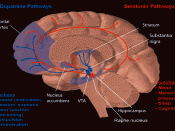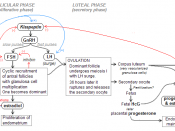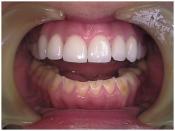BulimiaBulimia is a serious eating disorder. It affects primarily young women, adolescents to mid-twenties, but it does affect a small percentage of older women and men. It is a problem in at least five- percent of women. Bulimia is known as the bingeing and purging disease. But there are two different types of bulimic people. The purging type regularly engages in self-induced vomiting or the misuse of laxatives, diuretics or enemas. The non-purging type uses other inappropriate compensatory behaviours, such as fasting or excessive exercise, but does not regularly engage in self-induced vomiting or the misuse of laxatives, diuretics or enemas. People with bulimia eat compulsively bingeing and may consume up to 10,000 calories in one evening. Their weight can fluctuate from under to overweight. Four signs that indicate bulimia are repeated episodes of binge eating, repeated use of purging devices such as vomiting, a feeling of lack of control over binge eating, and an ongoing concern over body shape and weight.
Bulimia takes a toll on the body. It can cause serious health problems for over two million adolescent girls and young women in the United States. Individuals with disorders who use drugs to stimulate vomiting, bowel movements or urination (as most with bulimia do) may be in considerable danger, as this practice increases the risk of heart failure. In rare instances, binge eating causes the stomach to rupture; purging may result in heart failure due to loss of vital minerals such as potassium. Vomiting is a common source of problems. When a person vomits, he or she brings up partially digested food and stomach acid. The acid is very strong and can burn the digestive tract, the mouth, and the lips. It can also damage the teeth. Bingeing and purging disrupts the menstrual cycle.
The cause of bulimia is unknown, but it may sprout from a number of things. It can be partly their personality such as low self-esteem, feelings of helplessness and a fear of becoming fat. Both genetic and social factors are probably responsible. It does appear to run in families. An important factor contributing to bulimia is the social pressure for women to be thin. In countries where there is less focus on thinness, there are less eating disorders but, in countries where thinness is important for activities such as aerobics, there is higher number of girls with eating disorders.
Bulimia nervosa is usually treated with a combination of drugs and counselling. Psychotherapy is usually needed because bulimia is a psychiatric disorder. Intensive group therapy and anti-depressant medications have been proven to benefit patients.
Bulimia is a very serious eating disorder. For many it becomes a vicious circle that they can not break out of. Their chaotic pattern of eating comes to dominate their lives, but with help, and after many months and in some cases years, they can overcome bulimia.





